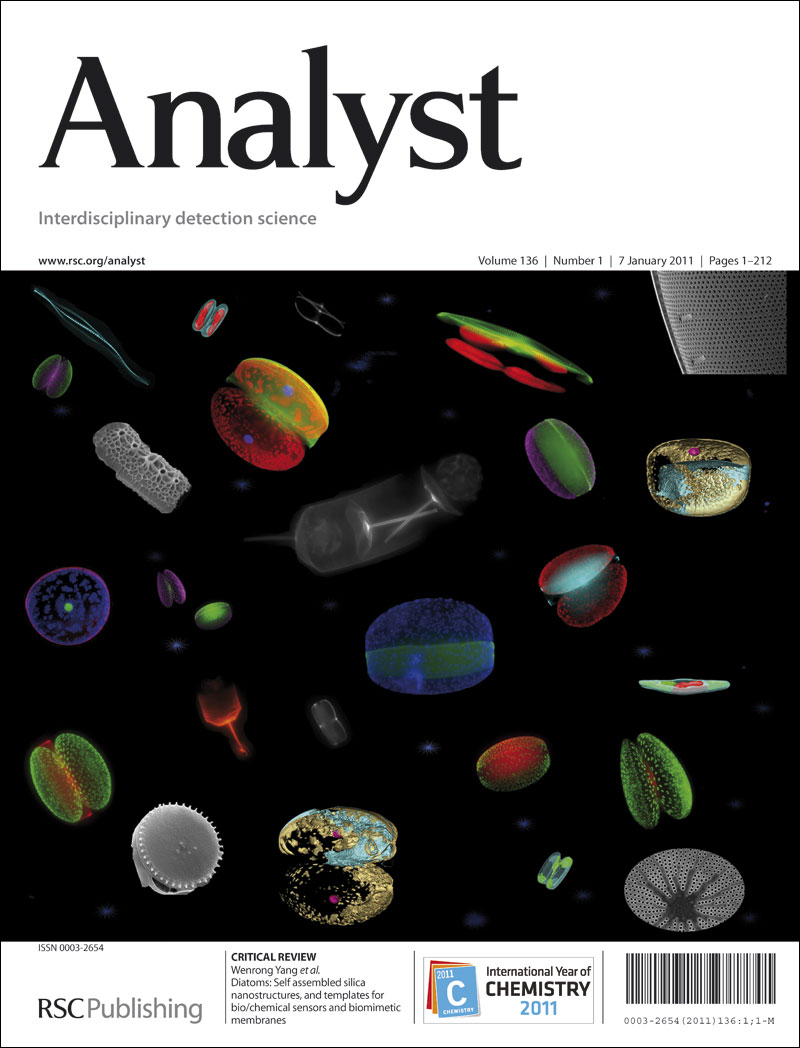Construction of an endogenously activated nanoamplifier for high-sensitivity detection and multimodal bioimaging of Alzheimer’s disease
IF 3.3
3区 化学
Q2 CHEMISTRY, ANALYTICAL
引用次数: 0
Abstract
Based on DNA hairpin structure, MnO₂ nanoflowers, and Tf-AuNCs, an endogenously-activated Tf-AuNCs-DNA@MnO2 multifunctional nanoamplifier was developed for the sensitive detection of microRNA-9 (miR-9) and efficient multimodal bioimaging in living AD cells and brain tissues by two-photon near-infrared fluorescence imaging (TP-NIRFI), fluorescence lifetime imaging (FLIM), and magnetic resonance imaging (MRI). The Tf-AuNCs-DNA@MnO2 multifunctional nanoamplifier exhibits superior two-photon near-infrared (TP-NIR) properties and extended fluorescence lifetimes. By an enzyme-free amplification technique. i.e., hybridization chain reaction (HCR), this approach can detect miR-9 with high selectivity and sensitivity and a low limit of detection (LOD) of 396 pM. In the brain tissue of AD mice, TP-NIRFI achieved a penetration depth of 290 μm and enabled a clear distinction between wild-type and APP/PS1 transgenic mice. Moreover, MRI could monitor H2O2 that induced activation of the multifunctional nanoamplifier in real time. More importantly, the Tf-AuNCs-DNA@MnO2 multifunctional nanoamplifier could monitor in real-time the dynamic changes of endogenous miR-9 induced by Aβ oligomers in HT-22 cells with multimodal imaging technology. Therefore, Tf-AuNCs-DNA@MnO2 multifunctional nanoamplifier can provide a comprehensive and in-depth understanding of the occurrence and development of AD, offering a new method and a powerful tool for early diagnosis of the diseases.用于阿尔茨海默病高灵敏度检测和多模态生物成像的内源性激活纳米放大器的构建
基于DNA发夹结构、mno2纳米花和Tf-AuNCs,开发了一种内源性激活Tf-AuNCs-DNA@MnO2多功能纳米放大器,用于对活AD细胞和脑组织中的microRNA-9 (miR-9)进行灵敏检测,并通过双光子近红外荧光成像(TP-NIRFI)、荧光寿命成像(FLIM)和磁共振成像(MRI)进行高效的多模态生物成像。Tf-AuNCs-DNA@MnO2多功能纳米放大器具有优异的双光子近红外(TP-NIR)性能和延长的荧光寿命。通过无酶扩增技术。即杂交链反应(HCR),该方法可以检测miR-9,具有高选择性和灵敏度,低检测限(LOD)为396 pM。在AD小鼠脑组织中,TP-NIRFI达到290 μm的穿透深度,使野生型和APP/PS1转基因小鼠明显区分。此外,MRI可以实时监测H2O2诱导的多功能纳米放大器的激活情况。更重要的是,Tf-AuNCs-DNA@MnO2多功能纳米放大器可以通过多模态成像技术实时监测Aβ低聚物诱导HT-22细胞内源性miR-9的动态变化。因此,Tf-AuNCs-DNA@MnO2多功能纳米放大器可以全面深入地了解AD的发生和发展,为疾病的早期诊断提供新的方法和有力的工具。
本文章由计算机程序翻译,如有差异,请以英文原文为准。
求助全文
约1分钟内获得全文
求助全文
来源期刊

Analyst
化学-分析化学
CiteScore
7.80
自引率
4.80%
发文量
636
审稿时长
1.9 months
期刊介绍:
"Analyst" journal is the home of premier fundamental discoveries, inventions and applications in the analytical and bioanalytical sciences.
 求助内容:
求助内容: 应助结果提醒方式:
应助结果提醒方式:


